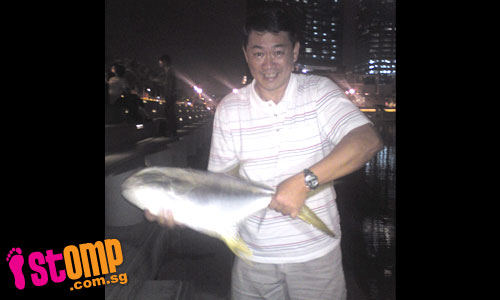
This lucky man caught a pomfret, weighing approximately 3kg, at Marina Bay Sands with his bare hands, before releasing it back into the water.
STOMPer maxikat, who witnessed the spectacle, said:
"There was a slight commotion at the Marina Bay Sands boardwalk tonight as a man, who only wanted to be known as Mr Chua, scooped a pomfret, estimated to be over 3kg in weight.
"The fish was observed to be swimming in a daze just under the surface of the water near the edge of the boardwalk.
"Mr Chua caught the fish out of the water with his bare hands, to the surprise and fright of several passers-by.
"The spectacle drew a small crowd to the scene.
"The fish was gently released back into the pitch dark waters of the Marina Bay water catchment area, to the applause of several onlookers."
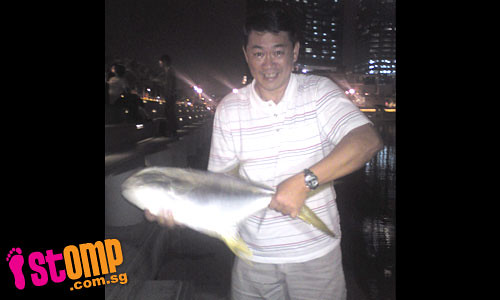


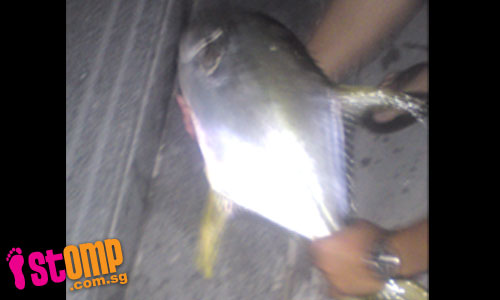
Despite its physical appearance, the fish in the photos is not a pomfret, but is most likely a pompano. The exact species is difficult to pin down, but a common representative is the snubnose pompano (Trachinotus blochii), which is also known as the snubnose dart. More information about this fish can be found in A Guide to Common Marine Fishes of Singapore.
Here are more photos of the snubnose pompano:

Maldives;
(Photo by MU5@)
![Buck-Nosed Trevally [Trachinotus blochii] in the Seychelles near the paradise island of Praslin. 2008.](http://farm4.static.flickr.com/3384/3346977278_b8bca04705.jpg)
Seychelles;
(Photo by Rud-gr)
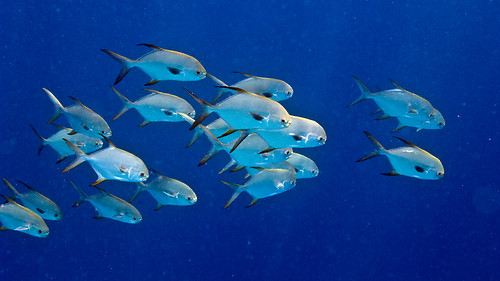
Maldives;
(Photo by Ülar Tikk)

Similan Islands;
(Photo by takau99)
The Pompanos
The snubnose pompano is just 1 of 20 known species of pompano, which belong to the genus Trachinotus. The pompano are part of the Carangidae, a large family which also encompasses various fishes known as jack, amberjack, scad, trevally, queenfish and horse mackerel. Pompano are highly prized in the seafood trade, as well as in both the commercial and recreational fishing industries.
Pompano as a whole are found in shallow coastal tropical and subtropical waters throughout the world. Habits vary between species; some prefer the clear waters above coral reefs, while others are more likely to be found swimming over sandy and muddy bottoms. Some species are known to patrol the surf zone, close to shore, while others will even enter estuaries. Some swim in large schools their entire lives, while others tend to become solitary as adults. And while all pompanos are predators, there are also differences in dietary preferences; some feed predominantly on smaller fishes, while others go for invertebrates such as worms, crustaceans and molluscs.
The snubnose pompano itself is known to grow up to 110 centimetres in length, but most individuals appear to max out at approximately half that size. It has a wide distribution across the tropical and subtropical Indo-Pacific, and within this vast area, tends to be found close to shallow coastal reefs and rocky outcrops. On the other hand, juvenile snubnose pompano prefer shallow sandy inshore habitats such as bays and river mouths, even entering brackish river estuaries. When young, snubnose pompano gather in small schools, whereas adults are usually more solitary. The diet consists mainly of benthic molluscs and other hard-shelled prey, which are crushed by the strong pharyngeal teeth.
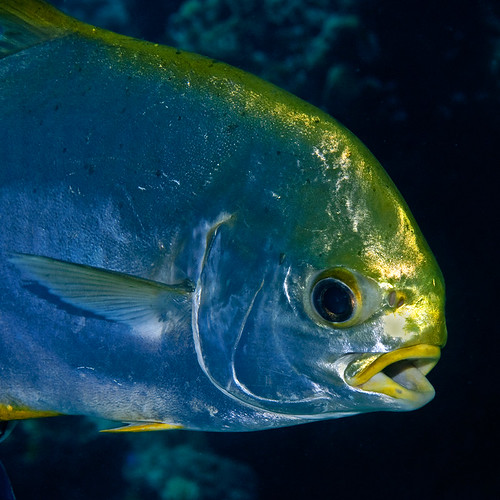
(Photo by Ülar Tikk)
Differences between different species of pompano may be subtle, and rely on very close comparison and examination of physical details, something that is not always possible when dealing with fast-swimming fish like pompano. In Australia, there is confusion between 2 species of pompano (known as permit there): the snubnose pompano and the oyster pompano (Trachinotus anak).
Besides the snubnose pompano, 2 other species of pompano are known to occur in Singapore, the Indian pompano (Trachinotus mookalee), and small spotted dart (Trachinotus baillonii). The Indian pompano is very similar to the snubnose pompano, but apparently is rarely encountered. With the only obvious differences being the length and colour of the dorsal, anal, and caudal fins, it can be difficult to tell the 2 species apart.

Small spotted dart, Maldives;
(Photo by SummerSound)
Seafood
The snubnose pompano is commonly seen in fish markets throughout the region, and is highly valued. A common local name for the snubnose pompano is golden pomfret, which probably explains the confusion with the various fish species more properly known as pomfrets. The snubnose pompano's popularity as a food fish can certainly be attributed to this alternative name; by associating it with the similarly shaped (but unrelated) pomfrets (Pampus spp.), it becomes even more marketable to consumers; pomfrets are among the more expensive fishes in the market.

Pomfrets at fish market;
(Photo by Jeaunse23)
Other local names include 金鲳鱼 (Chinese), kim chio (Hokkien) and bawal emas (Malay). Labeling it as pompano alone can be misleading, because that is the name given to a relative from the eastern Atlantic and Mediterranean (Trachinotus ovatus). Permit, another name that is occasionally used, is shared with a similar species from the western Atlantic (Trachinotus falcatus).
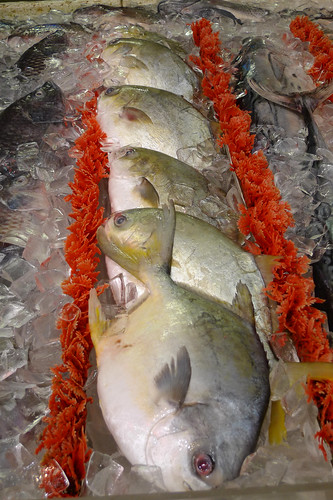
Pompano at fish market;
(Photo by tutincommon)
In order to meet demand, snubnose pompano have been raised on fish farms in many Asian countries, and Singapore is no exception. According to this review on aquaculture of 3 popular fish species in Singapore, farming of snubnose pompano locally was first introduced from Taiwan in the early 1990s. Juveniles from hatcheries in other countries are imported, then raised to market size in floating net cages. Fed on a diet of commercial pellets and trash fish, the fish take slightly less than a year to reach a size suitable for harvesting.
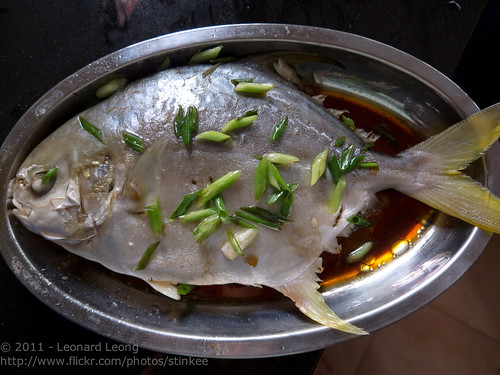
Steamed pompano;
(Photo by Stinkee Beek)
Pompano are also highly sought after by anglers and sport fishermen, with large numbers being stocked in some local fishing ponds.

Pompano weighing 4.32 kilograms, caught at a fishing pond in Pasir Ris;
(Photo by Factor-Six)
Pompano may also be caught in the shallow seas around Singapore.

Pompano weighing 6 kilograms, caught off Horsburgh Lighthouse;
(Photo by wooshaw)

Large pompano weighing 8 kilograms, caught off Changi;
(Photo by adrianlim07)

A day's catch, including several pompano, at Changi Beach;
(Photo by hairul fitrizan)
A fish out of water
The occurrence of a marine fish within the Marina Bay area is not too surprising, considering that the former river estuary is still in the process of transformation into a freshwater reservoir. It is possible that this particular fish was disoriented and unable to cope with the low salinity; although the snubnose pompano is known to inhabit brackish water habitats, it probably cannot survive in freshwater for long. Which could explain why it was described as being in a daze, rendering it possible for a person to catch it with his bare hands. Even though it was released, I would say that this fish is probably doomed.
According to this study, which surveyed the fishes of Marina Basin before the construction of the Marina Barrage, it would appear that a number of marine fishes would be unable to survive within the new Marina Reservoir. Although no pompano species were recorded during the survey, 4 other species of carangid fishes were found at Marina Channel, and given their tolerance for brackish waters, it is likely that snubnose pompano were also present but not caught. Like many other marine species, even if these fishes can survive the conversion of Marina Reservoir into a freshwater habitat, it is doubtful that they will be able to breed and sustain their populations.
Given that the snubnose pompano is a schooling fish, I wonder if there are any recent sightings or records of similarly dazed or even dead fish of the same species being found in the Marina Bay area. Or have they all already been caught and eaten by opportunistic anglers?
Another possibility is that this was a fish that had been purchased and then released into Marina Bay, in yet another misguided and poorly planned attempt at animal liberation to gain merit. It appears that in recent years, marine animals are the preferred choice of well-meaning Buddhist devotees; it is easy to purchase large numbers of fishes, and shellfish such as crabs, bivalves or conchs, and then either hire a boat and release the animals into the sea, or set them free at the beach. In fact, this particular photo gallery appears to document a release of juvenile snubnose pompano at a fish farm accessible from Changi Point.
My comments on this practice are best reserved for another time, but I am aware that there are a horrifying number of people who do not realise that they are releasing animals into habitats that are hostile or even deadly to them; in such cases, it includes releasing freshwater fishes into the sea, and vice versa. I would not be surprised if this particular pompano had been bought from a market, fish farm, or fishing pond, and then released into Marina Bay, with the person failing to even understand that marine fishes cannot survive in a freshwater reservoir in the first place. And of course, there is also the fact that Vesak Day is in a few days' time, which is highly suggestive that this was a botched attempt to grant this fish a better life.
Either way, I doubt this fish will be swimming in Marina Reservoir for much longer. I cannot find any information as to the current salinity of the water there, but I would suppose that a marine fish is ill-suited to survive there in the long run.
It is a fascinating sighting, and it does illustrate that our waterways are far from polluted and lifeless. However, this record also raises several questions regarding the origin of the fish; was it an unfortunate inhabitant of the original Marina Bay, trapped within an increasingly hostile environment? Or was it a hapless victim of misplaced good intentions?